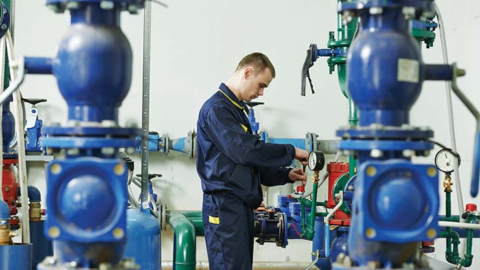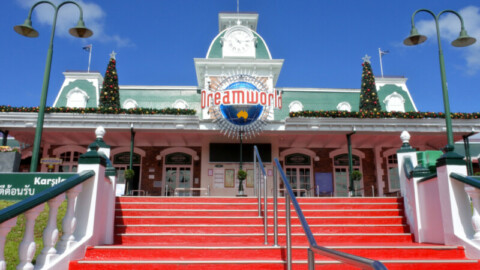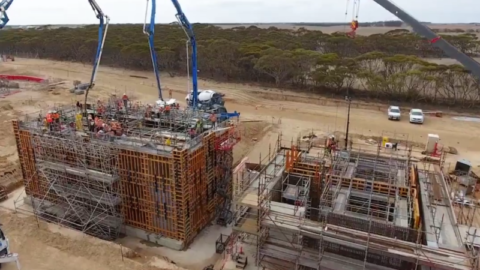Pumps are the second most commonly used machine in the world, however, they are also often overlooked by end users as a potential area where productivity can be improved and costs reduced. Here, we offer a round-up of all things pumps – covering the basics of pump types and their standard operation, as well as ways pump owners and operators can boost pump productivity, save energy and cut the costs and maintenance of pump operation.
Picking the right pump
Pumps are essential machines for countless industrial processes. Readily available in a breadth of designs that cater to a rich suite of applications, pumps tend to fall into two main groups: rotodynamic pumps, and positive displacement pumps.
Rotodynamic pumps
Rotodynamic pumps all have one thing in common: energy is transferred to the pumped fluid via a rotating element like an impeller, propeller, or rotor. In the most fundamental sense, rotodynamic pumps transfer mechanical energy into fluid kinetic energy, which ultimately changes to potential energy, or pressure, at the point of discharge.
Mechanically, rotodynamic pumps begin with a vacuum drawing the fluid to the impeller via suction, where the impeller then increases the liquid’s velocity, before the casing discharges the liquid at pressure.
Centrifugal pumps
A subset of rotodynamic pumps, centrifugal pumps are the most common type of pump due to their simple yet effective design and operation and involve a shaft-mounted impeller rotating unidirectionally within the pump’s casing. The components of a centrifugal pump include the impeller, pump casing, bearings and bearing frame, shaft, and mechanical seal. Centrifugal pumps can be single-stage, where the total head is the result of one impeller, or multistage, with a series of impellers aligned within one casing.
Centrifugal pumps can be further distinguished by the type of impeller at play:
• Radial flow impellers see liquid entering the impeller axially only to be discharged radially, altering the flow direction by 90 degrees. Radial flow impellers can be single or double suction, depending on whether fluid enters the impeller from one side or both
• Mixed flow impellers involve liquid entering the impeller axially to be discharged in both axial and radial directions. Like radial flow impellers, fluid entry can be either single or double suction
• Axial flow impellers are distinguished by liquid both entering and discharging radially so that flow does not change direction. Liquid entry for axial flow impellers is single suction only
To meet different requirements, centrifugal pumps can be self-priming or not self-priming, with further options of open, semi-open and closed impeller types.
Peripheral pumps
Also known as side channel or regenerative turbine pumps, peripheral pumps are a type of rotodynamic pump where energy is transferred to the fluid via the cells of a vane wheel impeller that hosts many radial blades. Because fluid is repeatedly circulated between a pump’s impeller and its casing channel, peripheral-type pumps obtain very high energy transference. Like centrifugal pumps, the impeller configuration of peripheral pumps can be either single-stage or multi-stage.
Specialty pumps
Further types of rotodynamic pumps are commonly named after the unique functions they employ. These specialty pumps include:
• Jet pumps
• Gas lift pumps
• Magnetic drive pumps
• Electro-magnetic pumps
Positive displacement pumps
Positive displacement pumps see force exerted on movable boundaries of enclosed, fluid-containing volumes, resulting in a direct increase in pressure. Positive displacement pumps tend to belong to either of two families: reciprocating pumps and rotary pumps.
Reciprocating pumps
Reciprocating pumps usually involve some kind of back-and-forth action in their design. These pumps typically incorporate a piston or plunger, diaphragm inlet and outlet valves, and a means for the piston or plunger and diaphragm to be actuated, such as an electric motor.
Reciprocating pumps can discharge liquid during only the forward motion of the piston – known as single acting – or during both forward and backward motions, known as double acting output. While plunger and diaphragm reciprocating pumps rely on single acting output, piston pumps may be double acting.
Reciprocating pumps may be further classified as follows:
• Simplex pumps – one single or double acting piston/plunger
• Duplex pumps – two single or double acting pistons/plungers
• Triplex pumps – three single or double acting pistons/plungers
• Multiplex pumps – more than three single or double acting pistons/plungers
Controlled volume pumps and air-operated double diaphragm pumps
Controlled volume pumps, also referred to as proportioning or metering pumps, are specialised reciprocating pumps that offer precise control of very low flow rates. Functionally, controlled volume pumps are typically used for the injection of chemical additives, the blending of proportions of multiple components, and the metered transfer of single liquids.
Controlled volume pumps are typically piston or plunger pumps, mechanical diaphragm pumps or hydraulically actuated diaphragm pumps.
Air-operated double diaphragm pumps are another type of reciprocating pump, characterised by being seal-free, self-priming and possessing the ability to run dry for long periods without over pressuring.
Rotary pumps
Rotary pumps, the second family of positive displacement pumps after reciprocating pumps, generally consist of gears, vanes, screws or similar elements enclosed within a casing. Importantly, rotary pumps have no separate inlet or outlet valves, and fluid flows through the pump in a uniform stream. Rotary pumps may be further classified into single rotor types and multiple rotor types.
Single rotor type pumps include:
• Vane pumps
• Piston pumps
• Flexible member pumps, and
• Screw pumps
Multiple rotor type pumps cover:
• Gear pumps
• Lobe pumps
• Circumferential piston pumps, and
• Multiple screw pumps
Getting the most out of your pump: from performance to profitability
What is BEP and why is it important to operations?
Every pump has an ideal range of operation where it is at its most efficient, and the peak flowrate at which a pump operates at its optimal efficiency for a specific impeller diameter is known as the best efficiency point (BEP). Knowing your pump’s BEP is a key factor when assessing your pump’s performance and if it is being operated properly.
This will allow you to determine how far your pump is operating from its BEP is critical to increasing pump reliability and efficiency. In general, most pumps will not consistently operate at their exact BEP due to process variables in the operating environment not being 100 per cent constant.
However, a pump that is properly sized for its application will maintain a flow near its peak efficiency, typically somewhere around 50-110 per cent of BEP depending on the pump type and application. Maintaining a flow between these levels will enable you to maximise efficiency while minimising the risks associated with operating too far off BEP. Unfortunately, many pumps do not achieve this level of efficiency.
The major reason a pump will operate away from its BEP is because it is incorrectly sized for the application. This can happen for a number of reasons, including:
• The pump is sized early in the planning and design phase using estimated values for pipework and fitting losses
• To account for the system design to potentially be expanded in a few years
• A pump was urgently needed and the right size was out of stock
• A pump was selected from the spares inventory due to budget constraints
• A new pump was bought to replace an existing pump that was already oversized
• A pump as oversized to account for expected build up of corrosion products on the pipe interior which would increase the pump total head requirement
• A “safety factor” may be added to increase pump capacity and head to counter the effects of wear

A pump that is operating too far away from its BEP will result in unnecessary power consumption and higher energy costs due to a higher performance in terms of flow and pressure requiring more power from the motor; as well as have a shorter mean time between maintenance and lifecycles due to problems such as cavitation, excessive vibration, temperature elevation, and reduced wear life of seals, shafts, impellers and bearings.
The types of issues that will arise from operating a pump away from BEP are impacted by whether it is being operated too far left or right of the BEP. A pump running to the right of its BEP, a condition known as runout, leads to higher flows than the pump was designed for, causing high velocities and turbulence.
This leads to high losses, local turbulence, localised stall and blockage in bottlenecks. At these higher flow rates, a twin vortex may be formed downstream of the impeller passage, and along with recirculation, there can be an increase in total pressure loss and energy wastage. Therefore, both efficiency and head are low when a pump is operating to the right of its BEP.
When a pump operates to the left of its BEP the discharge flow is restricted, and different sets of unsteady flows and unwanted effects are developed in the impeller passage and volute casing. Low flow rates can also cause recirculation within the pump, creating a low pressure area that can result in increased radial load and low flow cavitation.
Consequences of operating off BEP
Vibration and noise
These occur when a pump operates to the far right of BEP due to imbalances in pressure and shaft deflection from high velocity eddy currents putting stress on the pump’s internal components. This leads to poor performance, excessive wear and increased risk of failure. The ideal noise and vibration point is around 90 per cent of BEP.
Cavitation
Cavitation occurs when the intense pressure (up to 10,000 psi) and shock wave caused by vapour bubbles continuously forming and collapsing when the net positive suction head required (NPSHr) increases beyond the NPSH available (NPSHa) or NPSHa drops below the NPSHr.
Cavitation can include eroding of the impeller and vibration of the bearings and casings, causing damage that can be quite severe. When this occurs, the damaged metal can break away, creating pitted surfaces that become concentration points for further bubble collapse.
This bubble collapse can happen violently, causing sudden, uneven axial and radial loading on the impeller that can result in random and severe shaft deflection.
Bearing and seal failure
More than 80 per cent of all premature failures of centrifugal pumps is due to bearing and seal failure. Bearing and seal failure occurs when radial and thrust loads increase during off-BEP operation. These loads can lead to shaft deflection and mechanical seal failure, or the bearings being overloaded with increased temperatures. Depending on the volute casing design – single, dual or concentric – pumps will be more or less susceptible to radial and thrust load increases
System analysis and vibration management
While in an ideal world all pumps would be sized correctly and run at their BEP, real world conditions mean it is impractical to do so.
Processes are not static, the formulations change and production rates vary, but unlike processes the pumps that support them typically don’t change. In order to reduce the impact of running off BEP as much as possible and to maintain reliable pump operations, it is important to have a thorough maintenance program that monitors both machine health and pump operating conditions. There are a number of conditions that can be monitored that collectively provide a good picture of the overall cognition of a pump.
Pump performance monitoring
There are a number of important parameters that need to be monitored in order to have a clear understanding of how a pump is performing.
Suction and discharge pressure
Positive displacement pump systems work with a fixed amount of fluid that is trapped and mechanically displaced in a discharge pipe.
Monitoring pressure is important in these systems as overpressure can result from a dead head situation where the pump will not shut off and will continue to generate pressure even when there is no flow. This can result in the pressure climbing beyond the system limit, potentially leading to a pipe burst, pump lockup, a broken pump shaft or an overheated motor. This can not only result in high maintenance and material costs, but it can also be dangerous to anyone working near the pipes if something were to break.
For centrifugal pumps operating out of the optimal BEP, the impeller is subject to asymmetrical forces that can cause high vibration levels, excessive hydraulic thrust, increased temperature or erosion. Once the pressure reaches the dead head point, the flow will stop.
While unlike positive displacement pumps there is no risk of pipe bursting, the absence of flow will result in massive and unnecessary power consumption and operating expenses. Monitoring suction pressure and discharge pressure is vital for determining the Total Dynamic Head (TDH) of the pump and the available NPSHa.
Both suction and discharge pressure can be measured using either pressure transducers or installing taps for the pressure gauges. These should ideally be located in a straight section of the pipe as taps located in elbows or reducers will not accurately gauge the true static pressure due to the velocity head component, and if they are located in the top or bottom of the pipe, they can become air bound or clogged with solids.
Power monitoring
Pump power monitoring can also be a helpful tool to assess pump performance when combined with suction and discharge pressure readings.
Monitoring the amount of current a motor is using makes it possible to determine if the system is running as expected. For instance, if the amount of current increases dramatically, the pump is probably jammed, while a sudden drop in current indicates a possible blockage in the suction line or pin shear.
Current transducers are the easiest way to monitor motor power. Current transducers provide a signal that is directly related to the current being used by the motor which can then be used to trip an alarm or shut down the system. Low voltage pump load monitors can also be used to monitor pump power.
Flow measurements
Flow measurements can also be used to monitor pump efficiency. However, while it would be ideal that flow measurements could be obtained for all pumps, this is often impractical. Some systems have permanent flow meters installed to make monitoring easier, but these need to be checked regularly to ensure they are working properly and calibrated. Another solution is to use clamp-on ultrasonic flow meters, which can provide a flow accuracy on the range of one per cent. The challenges with these are that they are a temporary solution and they need to be clamped to a straight run of pipe.
Pump system analysis
When assessing pump performance and diagnosing any performance-related issue, having reference points to compare current performance is valuable. However, obtaining these reference points is often overlooked as it is assumed the system was constructed with an installed pump in mind, and operation is in accordance with design specifications. The problem is that pumps are rarely purchased as part of a comprehensive system design, rather as components to meet an individual process need.
The more information an engineer or end user has about the pumping systems, the more effective the maintenance program becomes, and the more understanding if the pumps are being operated optimally. Reference points that are typically used in a system analysis include NPSHa, NPSHr, static head, friction loss, and a review of the piping configuration and valving. These reference points can be obtained by looking at and knowing the system’s performance and system curves.
The published performance curve is only half of the information needed to predict pump performance, the other half is the system curve. A pump performance curve indicates how a pump will perform in regards to pressure head and flow, and is defined for a specific operating speed (rpm) and a specific inlet/outlet diameter.
On the other hand, the system curve tends to be more complex and difficult to understand. There are many reasons for this, including an impressions that it is too complex to ever understand, unfamiliarity with the pumping technology, the addition or subtraction of piping and pumps from the system over the years, accurate system diagrams aren’t available due to the number of alterations that have occured, or the original designer is no longer available due to the age of the system.
The system curve consists of flow and pressure, with the flow resistance plotted at fixed flow conditions – as long as no modulating valves or other transient components are being used. As well as flow and pressure, fiction loss and residual pressure also contribute to the system curve.
Friction loss is a piping system’s resistance to flow, while residual pressure is the system’s zero-flow backpressure and consists of static head and residual pressure difference between the source and destination.
Pump vibration analysis
While pumps will vibrate to a certain extent due to response from excitation forces, excessive vibration is a good indicator that some damaging conditions are occurring within a pump or the pump system. This makes vibration analysis a key tool to monitoring the performance of a pump.
The level of vibration in a pump is related to where it is operating in relation to its BEP – the further away from BEP it operates, the higher the vibrations will be. There is no definitive level of vibration that indicates there is a problem, but there are a number of guidelines – such as criteria developed on-site as a guideline, or by industry institutions that have developed independent criteria – that can be used as target values so alarm levels can be set. However, each installation is unique and a baseline vibration reading should be taken when a pump is initially started so that vibration levels can be trended over time – the operating point of the pump should also be recorded at this time.
Vibration measurements are typically taken on each bearing location in three planes: vertical, horizontal and axial. Frequency where the amplitude is occurring also needs to be considered as frequency can help to identify what defect is causing the problem and the amplitude can provide an indication of the problem’s severity.
Bearing defect analysis is also useful as each component of a roller bearing has a unique defect frequency which can be isolated using vibration equipment to determine if there is a problem with the bearing. This allows the pump to be shut down before catastrophic failure. Furthermore, bearing temperature should be monitored.
Continuous condition monitoring
Continuous monitoring uses dedicated devices that collect predictive maintenance-style data which can be used as part of a condition monitoring program to detect defects such as cracking, leaking or corrosion before the pump fails. These devices can provide key machine health indicators, including performance, including vibration, temperature, flow pressure and power.
There are numerous options for continuous monitoring: Wired systems, where equipment sensors are hard-wired to rack-based computer servers, with data accessed and analyzed over an internal network. These systems tend to be more expensive to implement but can provide more comprehensive process-related date Wireless systems, where sensors transmit data to a central hub, with data accessed and analysed over secure Internet connections. These systems are simple to install and there is a greater accessibility to the data Integrated systems, where hard-wired and wireless sensors feed data to an internal server-based network.




















